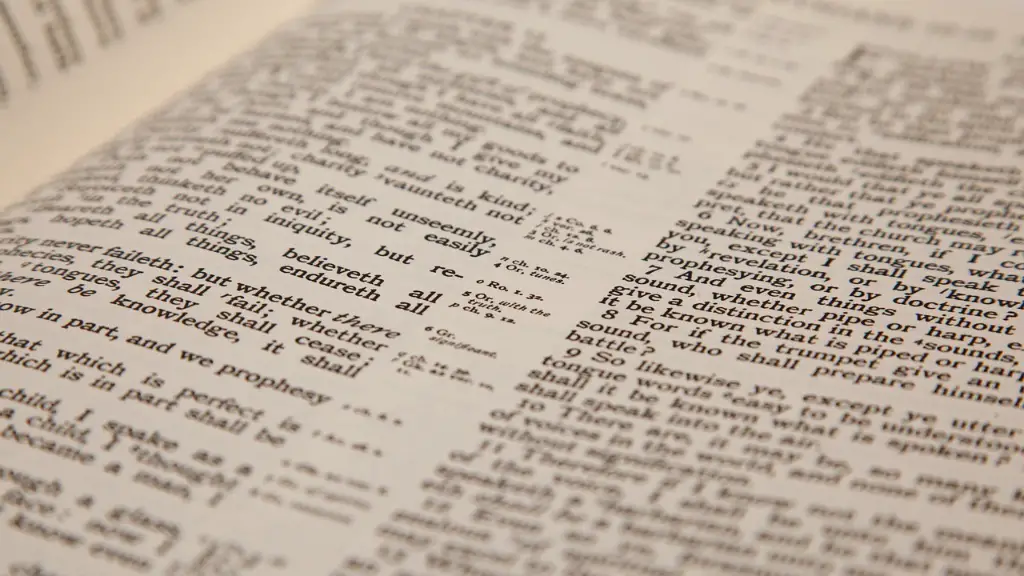Background Information
The mark of the beast is a mysterious symbol which appears in Chapter 13 of the Book of Revelation, the final book of the Bible. According to the book, anyone who bears this mark will be damned to suffer God’s wrath. Despite its significance, the Bible provides few clues as to what this infamous mark may be, leaving much room for speculation. Yet, by examining relevant passages, it is possible to consider what form this mark could take and its implications.
Bible Verses
The beast with seven heads and 10 horns that appears in Revelation 13 is described as imposing two distinct marks: a name and a number. The name is written “upon” the beast’s heads, but the exact meaning of this phrase is a matter of much dispute. Some interpret the phrase as signifying a literal physical mark, while others believe “upon” is an idiom for belonging to and offering allegiance to, so the mark is an internal sign of faith.
The number of the beast is given as 666, and Bible scholars have long been obsessed with the mystery of its meaning. Many connect it to ancient symbols or codes, and due to its clear numerical quality, some interpret 666 as the total value of someone’s name, calculated in the manner of Hebrew gematria.
More recently, the proliferation of biometric technologies such as facial recognition systems and credit cards has prompted believers to wonder if these indicate the true identity of the beast’s mark. Nevertheless, many oppose this view and say such technology cannot be the mark because these systems already exist and Revelation says the mark will be something introduced in the future.
Opinions of Experts
Theologians and Bible commentators often draw on both the spiritual and historical interpretations of the beast’s mark. Some point to the persecution of Christians by the Roman Empire as a telling metaphor for what will happen when the beast and its mark prevail in the future. Others believe the mark represents a spiritual covenant between the individual and the devil, a sign of idolatry, or a specific sin.
Still others view the mark as a means to control the global population. Supporters of this theory often cite Revelation 13, which states that no one will be able to buy or sell without the mark. This leads some to think the mark could take the form of a global economic system, whereby people have to have access to certain systems or technologies in order to take part in the global marketplace.
Analysing the Scriptures
Careful examination of the Bible reveals much about the beast and its mark. The fact that the number of the beast is mentioned frequently and that a warning is written alongside it implies the beast’s mark is something to be avoided at all costs. The use of the number 666 in Revelation 13 also suggests how the end times will unfold since the number is repeated three times. In particular, the passage stating no one can buy or sell without the mark appears to indicate a form of control over the global economy.
Implications
The mark of the beast greatly affects the lives of those who encounter it and brings with it dire consequences. In Revelation it is written “If anyone worships the beast and its image and receives a mark on their forehead or on their hand, they too will drink the wine of God’s fury” (Revelation 14:9-11). Similarly, the book of Paul encourages Christians to reject the beast’s mark and “take the mark of the Lord on [their] forehead” (Ephesians 6:17).
The Impact on Society
The mark of the beast remains a compelling and perplexing idea among many modern-day Christians. Many believers feel it is their responsibility to ensure no one is subjected to the mark’s torment and its implications for global society are considered. However, since the exact nature of the mark is still unknown, the best way to make sure it does not take hold is to spread awareness of what the mark could mean and to make sure those who encounter it will know to reject it.
How It Has Been Depicted
In recent years, the mark of the beast has been depicted in popular culture through books, television shows, and films. Through these mediums, the mark is often presented as a literal physical mark, like a tattoo or a brand, that is inscribed on a person’s forehead or right hand. This interpretation has even been incorporated into Christian art, particularly in paintings of the Last Judgment.
Modern Interpretations
Many scholars point to the ongoing development of biometric technologies as the likely identity of the mark of the beast. These technologies are increasingly being used to control access to services and products and to track people’s movements. In particular, facial recognition systems, microchip implants and virtual money transfers could theoretically be used to sign people up for a global economic system, subjugating them to the beast’s rule and forcing them to accept its mark.
Perpetuation of Fear
Despite the absence of clear indications as to what form the mark may take, the idea of it has spread far and wide. Many Christians see the mark as a representation of a future where the devil will prevail and the wicked will reign, leading to speculation and fear. Popular culture, too, draws upon this fear, using the mark as a source of horror and suspense in works of fiction.
False Promises
In some cases, the mark of the beast has become an excuse for individuals to indulge in their desires. Promises of power, strength and immortality are falsely associated with the mark and some may believe they can gain ultimate control over the world they inhabit by acquiescing to the beast’s will. They may also use it as an easy solution to challenging issues.
Enticement of False Prophets
In addition, some unscrupulous individuals, who claim to be religious prophets, also use the mark to entice people into a false religion or spiritual code of conduct. Through this, they can manipulate the masses, manipulating them into believing the false promises of the mark and leading them down a path of destruction. Moreover, these individuals often stoke fear and paranoia, further perpetuating the mystery surrounding the mark.
Connecting with the Divine
Ultimately, many Christians view the mark of the beast as symptomatic of a society that has strayed too far from divine principles. Despite the unknowns it presents and the fear it can inspire, believers strive for a deeper understanding of the mark and how it fits into the bigger picture of Christian faith. To that end, they look to their spiritual leaders for answers and guidance, and encourage others to do the same.



